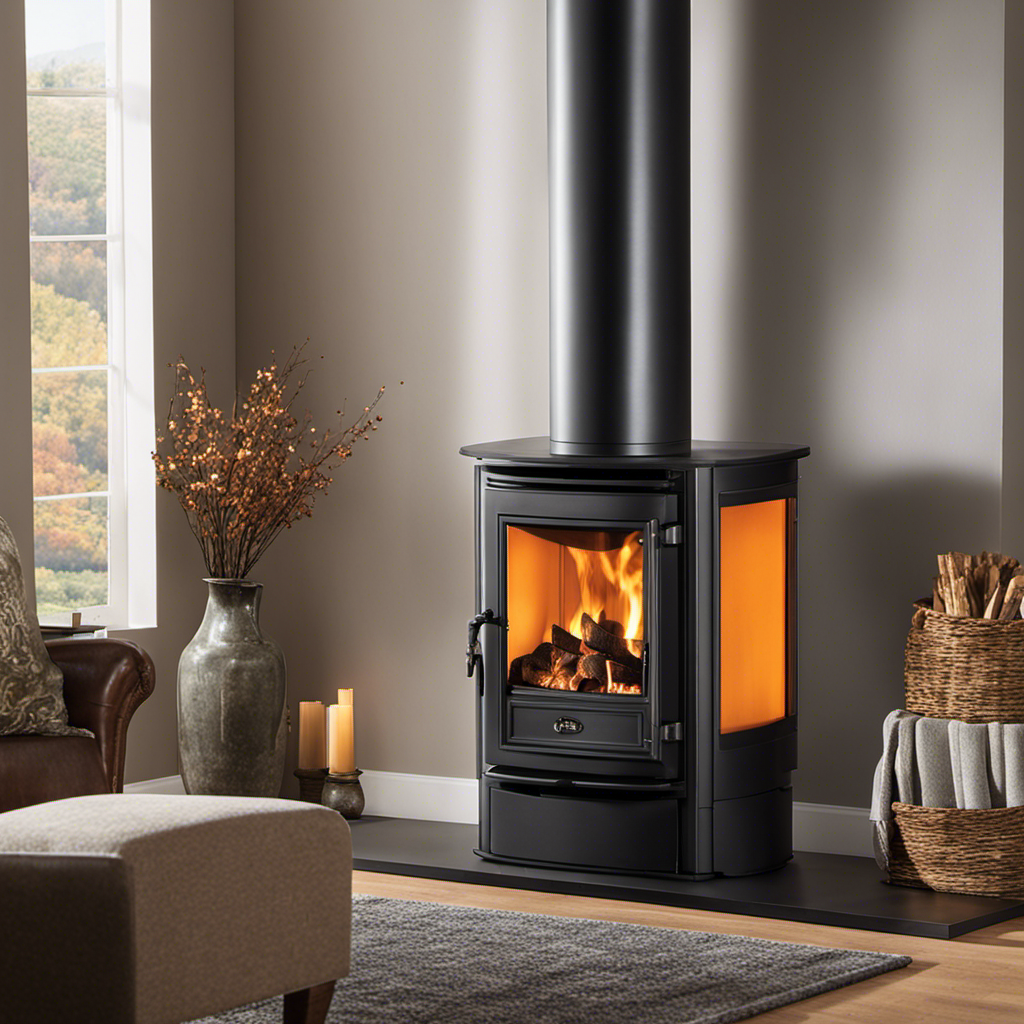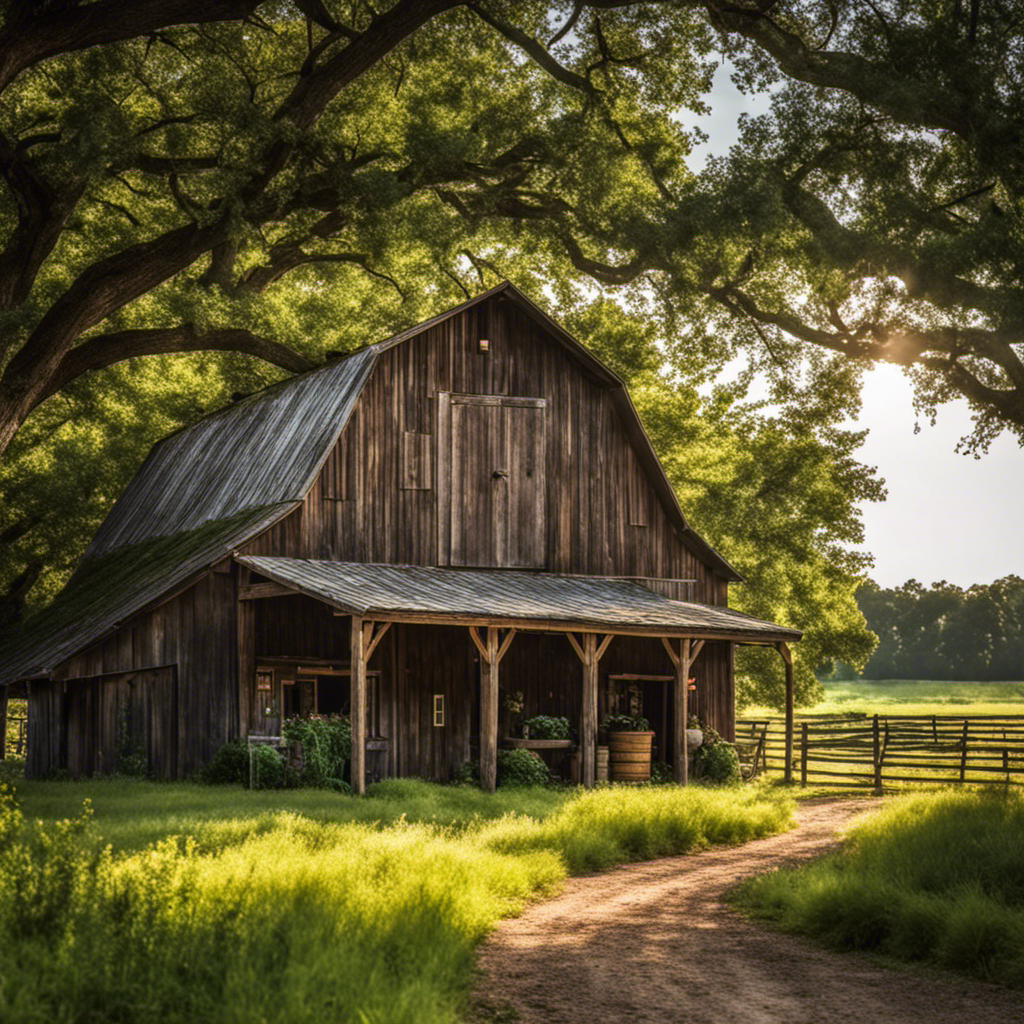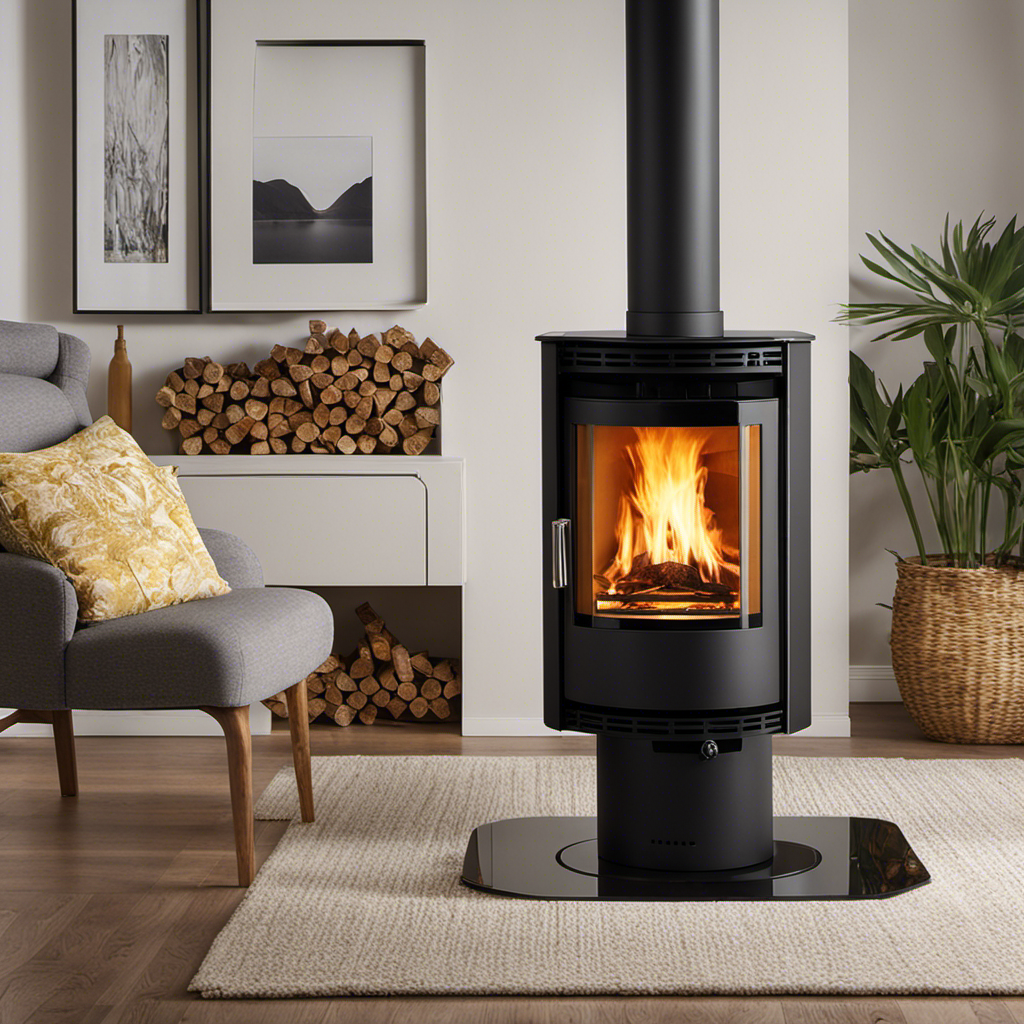Entering my snug living room during a cold winter night, the comforting noise of the wood popping in the fireplace instantly elevates my mood, filling the room with warmth.
It’s moments like these that make me wonder about the difference between a pellet stove and a wood-burning stove.
In this article, we’ll delve into the details and explore the various factors such as fuel source, heating efficiency, environmental impact, installation and maintenance, cost and availability, heating capacity, as well as aesthetics and design.
Let’s unravel the mystery together!
Key Takeaways
- Pellet stoves use compressed wood pellets made from waste materials, while wood burning stoves rely on logs or firewood.
- Pellet stoves have a lower carbon footprint and are considered eco-friendly, whereas wood burning stoves produce emissions when burned.
- Pellet stoves have automated feeding systems for efficient combustion, while wood burning stoves require manual loading and monitoring.
- Pellet stoves provide consistent and efficient heat, while wood burning stoves produce higher levels of radiant heat.
Fuel Source
You’ll find that a pellet stove uses compressed wood pellets as fuel, while a wood burning stove relies on logs or other types of firewood. Pellet stoves are designed to burn renewable energy in the form of compacted sawdust and shavings from lumber mills. These pellets are made from waste materials, making them an eco-friendly choice. By using this type of fuel, pellet stoves have a lower carbon footprint compared to wood burning stoves.
Wood burning stoves, on the other hand, rely on logs or firewood for fuel. While wood is a renewable resource, it does produce emissions when burned. This can contribute to air pollution and increase your carbon footprint.
Transitioning into the next section about heating efficiency, it’s important to note that both pellet stoves and wood burning stoves offer different levels of heating efficiency without compromising their unique fuel sources.
Heating Efficiency
When it comes to heating efficiency, there are three key points to consider.
Firstly, fuel consumption rates refer to how much fuel is needed to produce a certain amount of heat. This is important because it directly impacts the cost of heating. By understanding the fuel consumption rates of different heating systems, you can determine which option is more efficient and cost-effective.
Secondly, heat output levels indicate the amount of heat generated by a heating system and its ability to effectively warm a space. This is crucial in ensuring that your heating system can adequately heat your home or business. By comparing the heat output levels of different systems, you can choose one that will meet your heating needs.
Lastly, comparing heating costs helps determine which system is more cost-effective in terms of fuel usage and overall expenses. This involves considering not only the fuel consumption rates but also other factors such as maintenance costs and energy efficiency. By evaluating the overall heating costs, you can make an informed decision about the most efficient and affordable option.
Understanding these factors is essential in choosing an efficient heating option for your home or business. By considering fuel consumption rates, heat output levels, and heating costs, you can make a well-informed decision that meets your heating needs while saving you money.
Fuel Consumption Rates
The fuel consumption rates of pellet stoves and wood burning stoves can vary significantly. When it comes to renewable energy and reducing our carbon footprint, the type of stove we choose plays a crucial role. Here are two examples that highlight the differences:
-
Pellet Stove:
-
Uses compressed wood pellets as fuel.
-
These pellets are made from recycled sawdust or other biomass waste products.
-
The automated feeding system ensures consistent and efficient combustion.
-
Fuel consumption is measured in pounds per hour.
-
Wood Burning Stove:
-
Burns logs or split firewood.
-
Requires manual loading and monitoring for optimal performance.
-
Fuel consumption is measured in cords or stacks of firewood.
Considering these factors, it’s clear that pellet stoves offer better control over fuel consumption and utilize renewable resources effectively.
Now let’s explore another important aspect: heat output levels.
Heat Output Levels
Now let’s take a look at how the heat output levels of pellet stoves and wood burning stoves compare.
When it comes to heating technology, both pellet stoves and wood burning stoves rely on the combustion process to generate heat. However, there is a difference in their heat output levels.
Pellet stoves are known for providing consistent and efficient heat due to their advanced combustion systems. These stoves have sophisticated control mechanisms that regulate the amount of fuel being burned, resulting in steady and reliable heat production.
On the other hand, wood burning stoves tend to produce a higher level of radiant heat but may require more manual adjustments to maintain an optimal temperature.
Understanding these differences in heat output levels is important when considering which type of stove best suits your heating needs.
Moving onto the next section about ‘heating cost comparison’, it is essential to evaluate not only the heat output levels but also the economic aspects of using pellet or wood burning stoves.
Heating Cost Comparison
Let’s compare the heating costs of pellet stoves and wood burning stoves. When it comes to renewable energy sources, both options have their advantages. Here’s a breakdown of the key factors to consider:
-
Pellet Stoves:
-
Use compressed sawdust pellets as fuel
-
Generally more expensive upfront compared to wood burning stoves
-
Provide consistent and efficient heat output
-
Require electricity to operate the auger system that feeds pellets into the firebox
-
Have a lower carbon footprint due to cleaner combustion
-
Wood Burning Stoves:
-
Burn logs or firewood for fuel
-
Typically cheaper upfront cost compared to pellet stoves
-
Heat output may vary depending on wood quality and moisture content
-
Do not require electricity for operation, making them suitable for off-grid use
-
Have a higher carbon footprint due to emissions from incomplete combustion
Considering these factors, let’s now discuss the environmental impact of each option.
Environmental Impact
When comparing the emissions of pellet stoves and wood burning stoves, it is important to consider factors such as particulate matter, carbon monoxide, and greenhouse gas emissions.
Pellet stoves generally produce lower emissions compared to wood burning stoves due to their more efficient combustion process. Additionally, pellets are made from renewable fuel sources such as sawdust or agricultural waste, which makes them a more sustainable choice in the long run.
Emissions Comparison: Pellet Vs. Wood?
If you’re comparing emissions, pellet stoves generally produce lower emissions compared to wood burning stoves. This is due to their design and the use of compressed wood pellets as fuel. Pellet stoves are equipped with advanced combustion technology that ensures efficient and clean burning, resulting in reduced emissions. The pellets themselves are made from waste materials, such as sawdust or agricultural residue, which makes them a renewable resource. By using these pellets instead of traditional firewood, pellet stove owners contribute to emissions reduction and help protect the environment.
But it’s not just the environment that benefits from lower emissions. The health benefits cannot be ignored either. Wood smoke contains harmful pollutants like carbon monoxide, nitrogen oxides, and fine particulate matter that can have detrimental effects on respiratory health. Pellet stoves produce significantly less of these pollutants, leading to improved air quality indoors and outdoors.
So now that we know about the emission advantages of pellet stoves over wood burning stoves, let’s explore another important aspect: renewable fuel sources?
Renewable Fuel Sources?
To reduce your environmental impact, consider using renewable fuel sources in your stove. Renewable energy sources such as wood pellets and biomass can help lower your carbon footprint compared to traditional fossil fuels.
Wood pellets are made from compacted sawdust and other wood waste materials, while biomass refers to organic matter like agricultural residues or dedicated energy crops. These renewable fuels burn cleaner and emit fewer greenhouse gases compared to coal or oil, making them a more sustainable option for heating.
Using renewable fuel sources not only reduces our dependence on non-renewable resources but also contributes to the overall goal of mitigating climate change. Transitioning towards these alternatives is a crucial step in achieving long-term sustainability effects without compromising our comfort and convenience.
Long-Term Sustainability Effects?
Using renewable fuel sources in your stove can have long-term sustainability effects by reducing greenhouse gas emissions and our dependence on non-renewable resources. In addition to the environmental benefits, there are also significant long-term economic impacts associated with using renewable fuels. By utilizing renewable fuel sources such as wood pellets or biomass, you can reduce your reliance on costly fossil fuels, saving money over time. Furthermore, these sustainable fuel options are often locally sourced, supporting local economies and creating jobs in the community.
Another important aspect to consider when using renewable fuels in your stove is their impact on air quality. Compared to traditional fossil fuel-based stoves, stoves that utilize renewable fuels produce fewer harmful emissions and pollutants. This leads to improved air quality both indoors and outdoors. By choosing a stove that burns clean-burning renewable fuels, you can contribute to a healthier environment for yourself and those around you.
Transitioning into the subsequent section about installation and maintenance of pellet stoves…
Installation and Maintenance
When installing and maintaining a pellet stove, make sure to regularly clean the ash pan and check the venting system for any blockages. This is crucial for ensuring the safe and efficient operation of the stove.
Here are some key points to keep in mind during the installation process and for ongoing maintenance requirements:
-
Installation Process:
-
Choose a suitable location for your pellet stove, considering factors such as proximity to an exterior wall or chimney.
-
Follow manufacturer guidelines to properly connect and seal the venting system.
-
Maintenance Requirements:
-
Clean the ash pan regularly to prevent it from overflowing and affecting combustion efficiency.
-
Inspect and clean the venting system annually to remove any buildup that may restrict airflow.
By following these installation steps and maintenance practices, you can enjoy optimal performance from your pellet stove while minimizing potential issues.
Now let’s explore the cost and availability of pellet stoves without missing a beat.
Cost and Availability
The cost and availability of pellet stoves can vary depending on the region and demand. In general, pellet stoves are considered to be cost-effective compared to traditional wood-burning stoves. The initial investment for a pellet stove may be higher, but the long-term savings in fuel costs make it a popular choice for many homeowners. However, the availability of pellet stoves in rural areas can be limited due to transportation logistics and lower demand. To give you an idea of the cost range, here is a table showcasing average prices for different types of pellet stoves:
| Type of Pellet Stove | Average Cost |
|---|---|
| Freestanding | $1,500 – $3,000 |
| Insert | $2,000 – $4,000 |
| Fireplace | $3,000 – $6,000 |
| Boiler | $6,000 – $12,000 |
| Furnace | $8,000 – $15,000 |
Now that we have discussed the cost and availability aspect of pellet stoves let’s move on to exploring their heating capacity.
Heating Capacity
To determine if a pellet stove is suitable for your space, you’ll want to consider its heating capacity. This refers to the amount of heat output the stove can provide. Pellet stoves typically have a range of heating capacities, usually measured in British Thermal Units (BTUs). The heating capacity you need will depend on the size of the area you want to heat. It’s important to choose a stove with enough heating capacity to effectively warm your space without overworking the unit.
Additionally, it’s crucial to consider maintenance requirements when selecting a pellet stove. Regular cleaning and upkeep are necessary to keep the stove running efficiently and safely. Neglecting maintenance can lead to decreased performance or even potential fire hazards.
Aesthetics and Design
Now that we have discussed the heating capacity of pellet stoves and wood-burning stoves, let’s move on to another important aspect: aesthetics and design.
When it comes to aesthetics, both types of stoves offer different options to suit various preferences. Wood-burning stoves are often admired for their rustic and traditional appearance, with their cast iron or steel construction and beautiful designs. On the other hand, pellet stoves usually have a more modern look, featuring sleek lines and glass doors that allow you to enjoy the view of the burning pellets.
In terms of energy efficiency, both pellet stoves and wood-burning stoves can be highly efficient when properly maintained. However, pellet stoves tend to be slightly more efficient because they burn compressed wood pellets at a controlled rate, resulting in less wasted heat.
When it comes to safety features, both types of stoves have measures in place to ensure user safety. This includes heat shields around the stove body to prevent accidental burns, sturdy construction materials for durability and stability, as well as mechanisms for controlling air flow and preventing over-firing.
Overall, while both pellet stoves and wood-burning stoves excel in different areas of aesthetics and design, they are equally committed to providing energy-efficient heating solutions with proper safety features.
Frequently Asked Questions
Are Pellet Stoves and Wood Burning Stoves Equally Efficient in Heating a Room?
In my experience, pellet stoves and wood burning stoves are not equally efficient in heating a room. Pellet stoves have lower fuel costs compared to wood burning stoves, but wood burning stoves have a greater environmental impact.
How Often Do I Need to Clean and Maintain a Pellet Stove Compared to a Wood Burning Stove?
When comparing cleaning frequency and maintenance requirements of a pellet stove to a wood burning stove, it’s important to consider the type of fuel used. Pellet stoves generally require more frequent cleaning due to ash buildup, whereas wood burning stoves may need less frequent maintenance.
Can Pellet Stoves Be Installed in Existing Homes or Do They Require Special Ventilation Systems?
Installing a pellet stove in existing homes is possible, but it may require special ventilation systems. These systems ensure proper airflow and safety. It’s important to consult professionals for installation guidance and to comply with local building codes.
Are There Any Government Incentives or Tax Credits Available for Purchasing Pellet Stoves or Wood Burning Stoves?
There are government incentives and tax credits available for purchasing pellet stoves or wood burning stoves. These incentives can help offset the cost of installation and make these energy-efficient heating options more affordable for homeowners.
What Is the Average Lifespan of a Pellet Stove Compared to a Wood Burning Stove?
The average lifespan of a pellet stove is around 15-20 years, while a wood burning stove can last up to 25 years. In terms of energy efficiency, pellet stoves are more efficient than wood burning stoves.
Conclusion
Well, after diving deep into the world of pellet stoves and wood burning stoves, it’s clear that these two heating options are as different as night and day. From their fuel sources to their environmental impact, there are distinct contrasts that can’t be ignored.
But let’s not forget about installation and maintenance, cost and availability, heating capacity, and even aesthetics. It’s all part of the package when choosing between these two contenders.
So next time you’re debating which way to go for your home heating needs, remember this enlightening journey into the world of pellet stoves versus wood burning stoves.
Stay warm out there!











